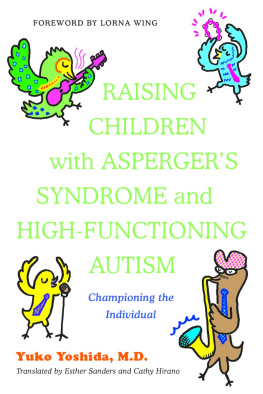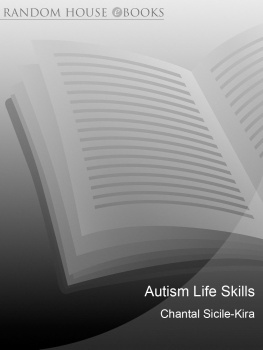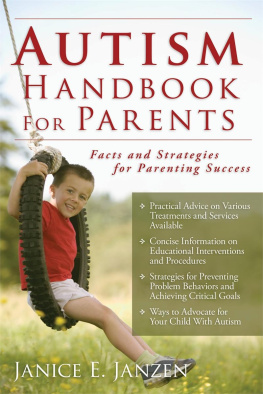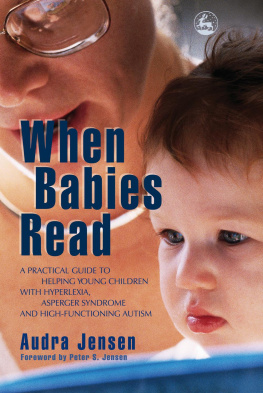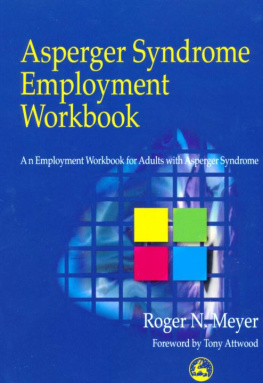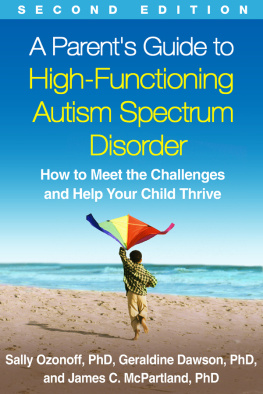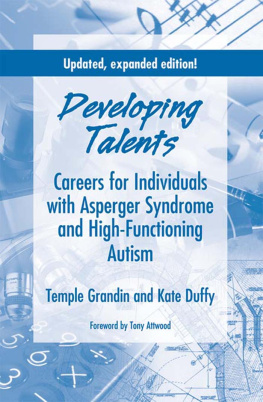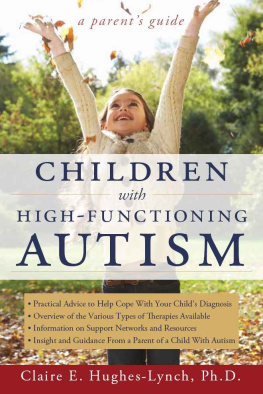About the Author
Yuko Yoshida is a graduate of the Jikei University School of Medicine and has served as manager of the medical departments at the North District Child Habilitation Centre of the City of Yokohama. She is currently a practicing psychiatrist specializing in child psychiatry at the Yokohama Psycho-Developmental Clinic. This is Dr. Yoshidas first book as the sole author in Japanese. It is her second publication in English, the first being How to Be Yourself in a World Thats Different: An Asperger Syndrome Study Guide for Adolescents . Her most recent Japanese language publication is Jiheisho/asuperuga shokogun jibun no koto no oshiekata (Teaching Kids about Their Autism or Aspergers Syndrome: A Manual for Supportive Disclosure; Gakken Education Publishing Co., Ltd., 2011). She was also a co-translator of The Autism Spectrum: A Guide for Parents and Professionals , by Lorna Wing (Constable Publishers, 1996), published in Japanese under the title of Jiheisho spekutoru: Oya to senmonka no tame no gaidobukku (Tokyo Shoseki Co., Ltd., 1998). She is also Managing Director of the Institute of Psychomedical Education for Children (iPEC): www.i-pec.jp.
About the Translators
Esther Sanders is a graduate of Vassar College with a B.A. degree in economics. She has lived and worked in Tokyo since 1987. Although primarily an English-language editor and Japanese-to-English translator, she has also worked as a tutor for international elementary school students with learning disabilities.
Cathy Hirano has lived in Japan since 1978 and graduated from the International Christian University (Tokyo, Japan) in 1983 with a B.A. degree in cultural anthropology. She has been working as a Japanese-to-English translator in various fields since she graduated.
Afterword
People who have had a happy childhood have a strength that lasts their whole life. A time may come when they forget all the little incidents that they experienced when they were small, but the memory of being loved and the feeling of being content will remain in their hearts. A childhood like this imparts a quiet strength in retrospect. No matter what abilities your child may lack, you are capable of giving him or her a happy childhood, and this is a job that only you can do. If you are armed with the right information and skills, your work as a parent will be even more effective. I am hoping that this book will help empower you in just this way.
When I was first asked to write this book, I did not have the confidence to write it on my own and waited about half a year before answering. I also hesitated to confine the topic to high-functioning preschoolers, as the IQs of children on the autism spectrum are particularly volatile at this age.
There are, however, many fathers and mothers raising children on the high-functioning end of the autism spectrum who are at their wits end. Their children are also at their wits end. And the fact that there are so few books to introduce to them is a problem I myself faced in treating them.
There are still many places where it is difficult to seek a diagnosis from a pediatric psychiatrist. Perhaps, I thought, communicating in print what I usually tell parents at the clinic will help those who are unable to take their child for a medical consultation. I realized, too, that as a practicing physician, it would be cowardly for me to refuse to report on the present state of knowledge just because I think there are still issues that have yet to be fully understood. And so, finally, I picked up my pen to write.
It was Dr. Tokio Uchiyama, director of the Yokohama Psycho-Developmental Clinic, and Masaru Kokubo of the Project Planning Department at Chuohoki Publishing Co., Ltd., who helped me make that decision. I express my profound gratitude to both of them. I am also indebted to Dr. Hiroshi Fujioka, director of the Tsubasa Psycho-Developmental Clinic, and Naomi Izuka, speech-language-hearing therapist at the Yokohama Psycho-Developmental Clinic, for their invaluable advice concerning the manuscript. In addition, without the clinical experience gained by working at the Yokohama City North Regional Treatment Centre, the Yokohama City Aoba Social Health and Welfare Centre, and the Yokohama Psycho-Developmental Clinic, I could never have written this book. I would like to express my sincere appreciation to all of the patients and staff who have furnished me with opportunities to practice. Further, I would like to express my gratitude to the eminent child psychiatrist Dr. Lorna Wing, who has had tremendous influence on the kind of physician I have striven to become.
And finally, I would like to thank, from the bottom of my heart, my son for so generously giving his absentminded and very busy mother a passing grade and continuous support, and my husband and expert in a related field, Dr. Manabu Yoshida, director of Yoshida Clinic, for repeatedly insisting that there was a need to publish this book.
Yuko Yoshida
June 2003
Appendix 1
Overview of Technical Terminology and Diagnostic Criteria
1. Aspergers Syndrome and the Autism Spectrum: the Wing Classification
The history of autism as a clinically recognized phenomenon dates back to 1943, when American child psychiatrist Leo Kanner published a report on eleven case histories (Kanner 1943). For this reason, autism is sometimes referred to as Kanners Syndrome. For a long time, autism was thought to be a very rare and serious disorder.
In 1979, British child psychiatrist Lorna Wing, along with fellow researcher Judith Gould, reported findings of a study they had conducted based on observations of all children enrolled in special education classes in a designated geographical area. They found that the subjects included a number of children who had the same developmental insufficiencies as those associated with autism but did not conform to Kanners descriptions and therefore had not been previously recognized as having features of autism. Wing was eager to draw attention to the existence of such children so that they might receive more of the supportive interventions that they needed. Central to her efforts was a paper written in 1944 by Austrian pediatrician Hans Asperger (Asperger 1944). This report described cases of children who showed a distinctive pattern of interaction with others, which he characterized as a sort of extravagance in personality and termed autistic psychopathy. Aspergers paper was virtually unknown in the English-speaking world, having been published in German during World War II.
In a 1981 paper, Wing presented Aspergers findings, adding her own original perspective and coining the term Aspergers Syndrome, describing the similarities between this disorder and autism (Wing 1981). She further proposed the use of the term autistic spectrum (in current parlance, autism spectrum) to encompass both autism and Aspergers Syndrome. Wings aim in devising this terminology was to see that people with Aspergers Syndromelike their counterparts with traditionally recognized autismreceive appropriate supportive interventions. She therefore directed attention to the common features of the two disorders and emphasized that distinguishing between these two types of individuals was not of great importance. Aspergers Syndrome as defined by Wing may be characterized as follows:
 The syndrome entails autism that appears at first glance not to be autism but is accompanied by the triad of impairments.
The syndrome entails autism that appears at first glance not to be autism but is accompanied by the triad of impairments.
 Individuals who are said to have the triad of impairments differ from those with typical autism and bear more similarity to the children described by Asperger. (For example, they give the superficial impression of being verbally fluent and yet have impaired communication, and they interact with others while lacking social reciprocity and common sense.)
Individuals who are said to have the triad of impairments differ from those with typical autism and bear more similarity to the children described by Asperger. (For example, they give the superficial impression of being verbally fluent and yet have impaired communication, and they interact with others while lacking social reciprocity and common sense.)
Next page
